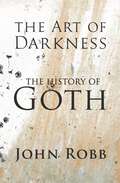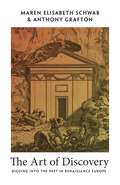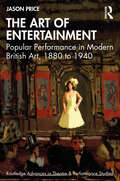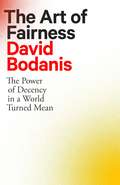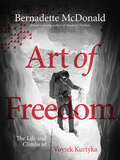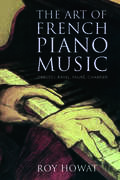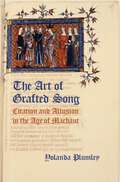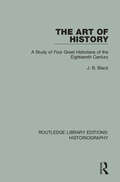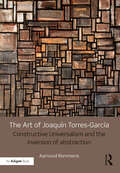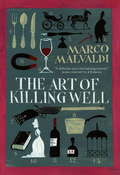- Table View
- List View
The Art of Darkness: The History of Goth (G - Reference,information And Interdisciplinary Subjects Ser.)
by John RobbThis is the first comprehensive history of goth music and culture. Across more than 500 pages, John Robb explores the origins and legacy of this enduring scene, which has its roots in the post-punk era.Drawing on his own experience as a musician and journalist, Robb covers the style, the music and the clubs that spawned the culture, alongside political and social conditions. He also reaches back further to key historic events and movements that frame the ideas of goth, from the fall of Rome to Lord Byron and the romantic poets, European folk tales, Gothic art and the occult. Finally, he considers the current mainstream goth of Instagram influencers, film, literature and music.The Art of Darkness features interviews with Siouxsie and the Banshees, The Cure, The Damned, Nick Cave, Southern Death Cult, Einstürzende Neubauten, Bauhaus, Killing Joke, Throbbing Gristle, Danielle Dax, Lydia Lunch and many more. It offers a first-hand account of being there at the gigs and clubs that made the scene happen.
The Art of Dining in Medieval Byzantium (Studies in Byzantine Cultural History)
by Lara FrentropThousands of intact ceramic bowls and plates as well as fragments made in the medieval Byzantine empire survive to this day. Decorated with figural and non-figural imagery applied in a variety of techniques and adorned with colourful paints and glazes, the vessels can tell us much about those who owned them and those who looked at them. In addition to innumerable ceramic vessels, a handful of precious metal bowls and plates survive from the period. Together, these objects make up the art of dining in medieval Byzantium. This art of dining was effervescent, at turns irreverent and deadly serious, visually stunning and fun. It is suggestive of ways in which those viewing the objects used a quotidian and biologically necessary (f)act – that of eating – to reflect on their lives and deaths, their aspirations and their realities. This book examines the ceramic and metal vessels in terms of the information offered on the foods eaten, the foods desired and their status; the spectacle of the banquet; the relationship between word and image in medieval Byzantium; the dangers of taste; the emergence of new moral and social ideals; and the use of dining as a tool in constructing and enforcing hierarchy. This book is of appeal to scholarly and non-scholarly audiences interested in the art and material culture of the medieval period and in the social history of food and eating.
The Art of Dining in Medieval Byzantium (Studies in Byzantine Cultural History)
by Lara FrentropThousands of intact ceramic bowls and plates as well as fragments made in the medieval Byzantine empire survive to this day. Decorated with figural and non-figural imagery applied in a variety of techniques and adorned with colourful paints and glazes, the vessels can tell us much about those who owned them and those who looked at them. In addition to innumerable ceramic vessels, a handful of precious metal bowls and plates survive from the period. Together, these objects make up the art of dining in medieval Byzantium. This art of dining was effervescent, at turns irreverent and deadly serious, visually stunning and fun. It is suggestive of ways in which those viewing the objects used a quotidian and biologically necessary (f)act – that of eating – to reflect on their lives and deaths, their aspirations and their realities. This book examines the ceramic and metal vessels in terms of the information offered on the foods eaten, the foods desired and their status; the spectacle of the banquet; the relationship between word and image in medieval Byzantium; the dangers of taste; the emergence of new moral and social ideals; and the use of dining as a tool in constructing and enforcing hierarchy. This book is of appeal to scholarly and non-scholarly audiences interested in the art and material culture of the medieval period and in the social history of food and eating.
The Art of Discovery: Digging into the Past in Renaissance Europe
by Maren Elisabeth Schwab Anthony GraftonA panoramic history of the antiquarians whose discoveries transformed Renaissance culture and gave rise to new forms of art and knowledgeIn the early fifteenth century, a casket containing the remains of the Roman historian Livy was unearthed at a Benedictine abbey in Padua. The find was greeted with the same enthusiasm as the bones of a Christian saint, and established a pattern that antiquarians would follow for centuries to come. The Art of Discovery tells the stories of the Renaissance antiquarians who turned material remains of the ancient world into sources for scholars and artists, inspirations for palaces and churches, and objects of pilgrimage and devotion.Maren Elisabeth Schwab and Anthony Grafton bring to life some of the most spectacular finds of the age, such as Nero’s Golden House and the wooden placard that was supposedly nailed to the True Cross. They take readers into basements, caves, and cisterns, explaining how digs were undertaken and shedding light on the methods antiquarians—and the alchemists and craftspeople they consulted—used to interpret them. What emerges is not an origin story for modern archaeology or art history but rather an account of how early modern artisanal skills and technical expertise were used to create new knowledge about the past and inspire new forms of art, scholarship, and devotion in the present.The Art of Discovery challenges the notion that Renaissance antiquarianism was strictly a secular enterprise, revealing how the rediscovery of Christian relics and the bones of martyrs helped give rise to highly interdisciplinary ways of examining and authenticating objects of all kinds.
The Art of Discovery: Digging into the Past in Renaissance Europe
by Maren Elisabeth Schwab Anthony GraftonA panoramic history of the antiquarians whose discoveries transformed Renaissance culture and gave rise to new forms of art and knowledgeIn the early fifteenth century, a casket containing the remains of the Roman historian Livy was unearthed at a Benedictine abbey in Padua. The find was greeted with the same enthusiasm as the bones of a Christian saint, and established a pattern that antiquarians would follow for centuries to come. The Art of Discovery tells the stories of the Renaissance antiquarians who turned material remains of the ancient world into sources for scholars and artists, inspirations for palaces and churches, and objects of pilgrimage and devotion.Maren Elisabeth Schwab and Anthony Grafton bring to life some of the most spectacular finds of the age, such as Nero’s Golden House and the wooden placard that was supposedly nailed to the True Cross. They take readers into basements, caves, and cisterns, explaining how digs were undertaken and shedding light on the methods antiquarians—and the alchemists and craftspeople they consulted—used to interpret them. What emerges is not an origin story for modern archaeology or art history but rather an account of how early modern artisanal skills and technical expertise were used to create new knowledge about the past and inspire new forms of art, scholarship, and devotion in the present.The Art of Discovery challenges the notion that Renaissance antiquarianism was strictly a secular enterprise, revealing how the rediscovery of Christian relics and the bones of martyrs helped give rise to highly interdisciplinary ways of examining and authenticating objects of all kinds.
The Art of Dying: A Raven and Fisher Mystery (Raven, Fisher, And Simpson Ser. #2)
by Ambrose ParryThere's a fine line between kill and cure. Edinburgh, 1849. Despite Edinburgh being at the forefront of modern medicine, hordes of patients are dying all across the city, with doctors finding their remedies powerless. But it is not just the deaths that dismay the esteemed Dr James Simpson. A whispering campaign seeks to blame him for the death of a patient in suspicious circumstances. Simpson’s protégé Will Raven and former housemaid Sarah Fisher are determined to clear their patron’s name. But with Raven battling against the dark side of his own nature, and Sarah endeavouring to expand her own medical knowledge beyond what society deems acceptable for a woman, the pair struggle to understand the cause of the deaths. Will and Sarah must unite and plunge into Edinburgh’s deadliest streets to clear Simpson’s name. But soon they discover that the true cause of these deaths has evaded suspicion purely because it is so unthinkable.
The Art of English Poesy: A Critical Edition
by George PuttenhamGeorge Puttenham's Art of English Poesy is a foundational work of English Renaissance criticism and literary theory. Rich in detail about the nature, purpose, and functions of poetry as well as the poet's character and goals, it is also a valuable historical document, offering generous insight into Elizabethan court culture, implicitly on display in the attitudes and values of the writer. His illustrative anecdotes enable us to watch European courtiers negotiating their social and political relationships with one another as well as with rulers and social inferiors.This new critical edition of The Art of English Poesy contains the first modernized and fully annotated edition of Puttenham's 1589 text; a substantial introductory essay by Frank Whigham and Wayne A. Rebhorn; a comprehensive bibliography; several glossaries and appendixes; and an index. The editors' masterly essay introduces Puttenham to modern readers and situates The Art of English Poesy in the context of the rhetorical theory, poetics, and courtly conduct of its time. The introduction also includes a concise biography of Puttenham based on a variety of new and unfamiliar data: he married an older and much richer woman whom he badly mistreated; indulged habitually in a life of sexual predation; was repeatedly sued, arrested, and imprisoned; survived several supposed attempts on his life; and died, nearly indigent, in 1591. For scholars and students of the English Renaissance, the Cornell edition of The Art of English Poesy should prove the definitive edition of Puttenham's major work.
The Art of Entertainment: Popular Performance in Modern British Art, 1880 to 1940 (ISSN)
by Jason PriceIn this book, theatre historian Jason Price looks at the relationships and exchanges that took place between high and low cultural forms in Britain from 1880 to 1940, focusing on the ways in which figures from popular entertainments, such as music hall serio-comics, clowns, and circus acrobats, came to feature in modern works of art.Readers with an interest in art, theatre, and the history of modern Britain will find Price’s approach, which sees major works of art used to illuminate the histories of once-famous entertainers and the wider social, political, and cultural landscape of this period, accessible and engaging. The book will bring to life for readers some of the most vivid works of modern British art and reveal how individuals historically overlooked due to their gender, sexuality, or race played a significant role in the shaping of British culture during this period of monumental social change.
The Art of Entertainment: Popular Performance in Modern British Art, 1880 to 1940 (ISSN)
by Jason PriceIn this book, theatre historian Jason Price looks at the relationships and exchanges that took place between high and low cultural forms in Britain from 1880 to 1940, focusing on the ways in which figures from popular entertainments, such as music hall serio-comics, clowns, and circus acrobats, came to feature in modern works of art.Readers with an interest in art, theatre, and the history of modern Britain will find Price’s approach, which sees major works of art used to illuminate the histories of once-famous entertainers and the wider social, political, and cultural landscape of this period, accessible and engaging. The book will bring to life for readers some of the most vivid works of modern British art and reveal how individuals historically overlooked due to their gender, sexuality, or race played a significant role in the shaping of British culture during this period of monumental social change.
The Art of Fairness: The Power of Decency in a World Turned Mean
by David Bodanis'David Bodanis is an enthralling storyteller. Prepare to be taken on a surprising, wide-ranging and ultimately inspiring journey to explore what makes us human' Tim HarfordCan you succeed without being a terrible person? We often think not: recognising that, as the old saying has it, 'nice guys finish last'. But does that mean you have to go to the other extreme, and be a bully or Machiavellian to get anything done?In THE ART OF FAIRNESS, David Bodanis uses thrilling historical case studies to show there's a better path, leading neatly in between. He reveals how it was fairness, applied with skill, that led the Empire State Building to be constructed in barely a year - and how the same techniques brought a quiet English debutante to become an acclaimed jungle guerrilla fighter. In ten vivid profiles - featuring pilots, presidents, and even the producer of Game of Thrones - we see that the path to greatness doesn't require crushing displays of power or tyrannical ego. Simple fair decency can prevail.With surprising insights from across history - including the downfall of the very man who popularised the phrase 'nice guys finish last' - THE ART OF FAIRNESS charts a refreshing and sustainable new approach to cultivating integrity and influence.
Art of Freedom: The life and climbs of Voytek Kurtyka
by Bernadette McDonaldVoytek Kurtyka is one of the greatest alpinists of all time. Born in 1947, he was one of the leading lights of the Polish golden age of mountaineering that redefined Himalayan climbing in the 1970s and 1980s.His visionary approach to climbing resulted in many renowned ascents, such as the complete Broad Peak traverse, the ‘night-naked’ speed climbs of Cho Oyu and Shishapangma and, above all, the alpine-style first ascent of the West Face of Gasherbrum IV. Dubbed the ‘climb of the century’, his route on GIV with the Austrian Robert Schauer is – as of 2017 – unrepeated. His most frequent climbing partners were alpine legends of their time: Polish Himalayan giant Jerzy Kukuczka, Swiss mountain guide Erhard Loretan and British alpinist Alex MacIntyre.After repeated requests to accept the Piolets d’Or Lifetime Achievement Award (the Oscars of the climbing world), Kurtyka finally accepted the honour in the spring of 2016. A fiercely private individual, he has declined countless invitations for interviews, lectures and festival appearances, but he has agreed to collaborate with internationally renowned and award-winning author Bernadette McDonald on this long-awaited biography.Art of Freedom is a profound and moving profile of one of the international climbing world’s most respected, complex and reclusive mountaineers.
The Art of French Piano Music: Debussy, Ravel, Fauré, Chabrier
by Roy HowatAn essential resource for scholars and performers, this study by a world-renowned specialist illuminates the piano music of four major French composers, in comparative and reciprocal context. Howat explores the musical language and artistic ethos of this repertoire, juxtaposing structural analysis with editorial and performing issues. He also relates his four composers historically and stylistically to such predecessors as Chopin, Schumann, Liszt, the French harpsichord school, and Russian and Spanish music. Challenging long-held assumptions about performance practice, Howat elucidates the rhythmic vitality and invention inherent in French music. In granting Fauré and Chabrier equal consideration with Debussy and Ravel, he redresses a historic imbalance and reshapes our perceptions of this entire musical tradition. Outstanding historical documentation and analysis are supported by Howat’s direct references to performing traditions shaped by the composers themselves. The book balances accessibility with scholarly and analytic rigor, combining a lifetime’s scholarship with practical experience of teaching and the concert platform
The Art of Grafted Song: Citation and Allusion in the Age of Machaut
by Yolanda PlumleyJust as our society delights in citations, quotations, and allusions in myriad contexts, not least in popular song, late medieval poets and composers knew well that such references could greatly enrich their own works. In The Art of the Grafted Song: Citation and Allusion in the Age of Machaut, author Yolanda Plumley explores the penchant for borrowing in chansons and lyrics from fourteenth-century France, uncovering a practice integral to the experiments in form, genre, and style that ushered in a new school of lyric. Working across disciplinary boundaries, Plumley traces creative appropriations in the burgeoning "fixed forms" of this new tradition to build a more intimate understanding of the shared experience of poetry and music in the generations leading up to, and including, Guillaume de Machaut. Exploring familiar and less studied collections of songs as well as lyrics without music, this book sheds valuable light on the poetic and musical knowledge of authors and their audiences, and on how poets and composers devised their works and engaged their readers or listeners. It presents fresh insights into when and in which milieus the classic Ars nova polyphonic chanson took root and flourished, and into the artistic networks of which Machaut formed a part. As Plumley reveals, old songs lingered alongside the new in the collective imagination well beyond what the written sources imply, reminding us of the continued importance of memory and orality in this age of increasing literacy. The first detailed study of citational practice in the French fourteenth-century song-writing tradition, The Art of Grafted Song will appeal to students and scholars of medieval French music and literature, cultural historians, and others interested in the historical and social context of music and poetry in the late Middle Ages.
The Art of History: A Study of Four Great Historians of the Eighteenth Century (Routledge Library Editions: Historiography)
by J. B. BlackThe first important scholarly consideration of Enlightenment historiography of the twentieth century, this book, originally published in 1926, critically examines the ideas of Voltaire, Hume, Robertston and Gibbon with respect to the theory and practice of historiography. The substantial introduction outlines the main differences between the ideals of these literary-philosophical schools and those which prevailed among historians in the early 20th century. The author argues that history can never be devoid of philosphical and literary interest, and that if it concerns itself merely with the stablishment of fact, will be a discipline of "contracting horizons".
The Art of History: A Study of Four Great Historians of the Eighteenth Century (Routledge Library Editions: Historiography)
by J. B. BlackThe first important scholarly consideration of Enlightenment historiography of the twentieth century, this book, originally published in 1926, critically examines the ideas of Voltaire, Hume, Robertston and Gibbon with respect to the theory and practice of historiography. The substantial introduction outlines the main differences between the ideals of these literary-philosophical schools and those which prevailed among historians in the early 20th century. The author argues that history can never be devoid of philosphical and literary interest, and that if it concerns itself merely with the stablishment of fact, will be a discipline of "contracting horizons".
Art of Illness: Malingering and Inventing Health Conditions (Routledge Advances in the History of Bioethics)
by Wendy J. TurnerThere is a long history of inventing illness, such as pretending to be sick for attention or accusing others of being ill. This volume explores the art of illness, and the deceptions and truths around health and bodies, from a multiplicity of angles from antiquity to the present. The chapters, which are based on primary-source evidence ranging from antiquity to the late twentieth century, are divided into three sections. The first part explores how the idea of faking illness was understood and conceptualized across multiple fields, locations, and time periods. The second part uses case studies to emphasize the human element of those at the center of these narratives and how their behavior was shaped by societal attitudes. The third part investigates the development of regulations and laws governing malingering and malingerers. Altogether, they paint a picture of humans doing human actions—cheating, lying, stealing, but also hiding, surviving, working. This book’s careful, accessible scholarship is a valuable resource for academics, scientists, and the sophisticated undergraduate audience interested in malingering narratives throughout history.
Art of Illness: Malingering and Inventing Health Conditions (Routledge Advances in the History of Bioethics)
There is a long history of inventing illness, such as pretending to be sick for attention or accusing others of being ill. This volume explores the art of illness, and the deceptions and truths around health and bodies, from a multiplicity of angles from antiquity to the present. The chapters, which are based on primary-source evidence ranging from antiquity to the late twentieth century, are divided into three sections. The first part explores how the idea of faking illness was understood and conceptualized across multiple fields, locations, and time periods. The second part uses case studies to emphasize the human element of those at the center of these narratives and how their behavior was shaped by societal attitudes. The third part investigates the development of regulations and laws governing malingering and malingerers. Altogether, they paint a picture of humans doing human actions—cheating, lying, stealing, but also hiding, surviving, working. This book’s careful, accessible scholarship is a valuable resource for academics, scientists, and the sophisticated undergraduate audience interested in malingering narratives throughout history.
The Art of Innovation: From Enlightenment to Dark Matter
by Ian Blatchford Tilly Blyth------------------------------------------------------------------------------------Based on the landmark Radio 4 series, and Science Museum exhibition, this illustrated modern history of the connections between science and art reveals a new perspective on what that relationship has contributed to the world around us. Throughout history, artists and scientists have been driven by curiosity and the desire to experiment. Both have wanted to make sense of the world around them, often to change it, sometimes working closely together, certainly taking inspiration from each other’s disciplines. The relationship between the two has traditionally been perceived as one of love and hate, fascination and revulsion, symbiotic but antagonistic. But art is crucial to helping us understand our science legacy and science is well served by applying an artistic lens. How exactly has the ingenuity of science and technology been incorporated into artistic expression? And how has creative practice, in turn, stimulated innovation and technological change?The Art of Innovation is a history of the past 250 years viewed through the disciplines of art and science. Through fascinating stories that explore the sometimes unexpected relationships between famous artworks and significant scientific and technological objects – from Constable’s cloudscapes and the chemist who first measured changes in air pressure, to the introduction of photography and the representation of natural history in print – it offers a new way of seeing, studying and interpreting the extraordinary world around us.
The Art of Insurgency: American Military Policy and the Failure of Strategy in Southeast Asia (Non-ser.)
by Donald W. HamiltonIn his analysis of insurgency war, Donald Hamilton first attempts to provide insight into a strategic concept he believes is little understood today, and to explain its complicated relationship to American policy failures in Southeast Asia during the post-1945 era of containment. The study develops a working model of insurgency, explaining it as both a unique method and type of war-making. Significant findings include the inability of policymakers to perceive a potential insurgency in Vietnam as early as 1946, subsequent American involvement in not one, but three Asian insurgencies during the 1950s, and the ultimate failure of the U.S. military to meet the insurgency challenge in South Vietnam. This inability to eliminate the insurgency led not only to the complete breakdown of the South Vietnamese government, but was the primary reason why further U.S. military action after 1965 would prove ineffectual. This historical narrative also follows the involvement of several key players, including the personalities of Edward Lansdale, Sir Robert Thompson, Archimedes Patti, and Vo Nguyen Giap, who through their life experiences and writings, provide a keen profundity into why insurgencies occur, why they fail, and why they succeed.
The Art of Invective: Selected Non-Fiction 1953-1994
by Dennis PotterForeword by Peter Bowker Edited by Ian Greaves, David Rolinson and John Williams Dennis Potter (1935–94) was Britain’s leading television dramatist for almost thirty years and remains an inspiration to today’s programme makers as a result of such groundbreaking work as Pennies from Heaven, Blue Remembered Hills and The Singing Detective. But he also engaged with his audience through reviews, journalism, interviews, broadcasts and speeches. The Art of Invective, the first collection of its kind, brings together some of his finest non-fiction work. Published to mark 80 years since Potter’s birth, this book includes his merciless television columns, penetrating literary criticism and angry writings on class and politics, as well as his sketches for Sixties satire shows including That Was the Week That Was. From Frost-Nixon to Coronation Street, David Hare to Doctor Who, Orwell to Emu, this collection shows Potter’s distinctive voice at its entertaining, thought-provoking and uncompromising best.
The Art of Joaquín Torres-García: Constructive Universalism and the Inversion of Abstraction
by Aarnoud RommensIntertwining art history, aesthetic theory, and Latin American studies, Aarnoud Rommens challenges contemporary Eurocentric revisions of the history of abstraction through this study of the Uruguayan artist Joaquín Torres-García. After studying and painting (for decades) in Europe, Torres-García returned in 1934 to his native home, Montevideo, with the dream of reawakening and revitalizing what he considered the true indigenous essence of Latin American art: "Abstract Spirit." Rommens rigorously analyses the paradoxes of the painter's aesthetic-philosophical doctrine of Constructive Universalism as it sought to adapt European geometric abstraction to the Americas. Whereas previous scholarship has dismissed Torres-García's theories as self-contradictory, Rommens seeks to recover their creative potential as well as their role in tracing the transatlantic routes of the avant-garde. Through the highly original method of reading Torres-García's artworks as a critique on the artist's own writings, Rommens reveals how Torres-García appropriates the colonial language of primitivism to construct the artificial image of "pure" pre-Columbian abstraction. Torres-García thereby inverts the history of art: this book teases out the important lessons of this gesture and the implications for our understanding of abstraction today.
The Art of Joaquín Torres-García: Constructive Universalism and the Inversion of Abstraction
by Aarnoud RommensIntertwining art history, aesthetic theory, and Latin American studies, Aarnoud Rommens challenges contemporary Eurocentric revisions of the history of abstraction through this study of the Uruguayan artist Joaquín Torres-García. After studying and painting (for decades) in Europe, Torres-García returned in 1934 to his native home, Montevideo, with the dream of reawakening and revitalizing what he considered the true indigenous essence of Latin American art: "Abstract Spirit." Rommens rigorously analyses the paradoxes of the painter's aesthetic-philosophical doctrine of Constructive Universalism as it sought to adapt European geometric abstraction to the Americas. Whereas previous scholarship has dismissed Torres-García's theories as self-contradictory, Rommens seeks to recover their creative potential as well as their role in tracing the transatlantic routes of the avant-garde. Through the highly original method of reading Torres-García's artworks as a critique on the artist's own writings, Rommens reveals how Torres-García appropriates the colonial language of primitivism to construct the artificial image of "pure" pre-Columbian abstraction. Torres-García thereby inverts the history of art: this book teases out the important lessons of this gesture and the implications for our understanding of abstraction today.
The Art of John Webster (Routledge Revivals)
by Ralph BerryThe Art of John Webster, first published in 1972, is a study of the three extant plays of Webster known to be solely his work. These plays are seen as attempts to achieve in literature the effects of the baroque, a term which related Webster to the larger developments of European art. Their content is analysed in terms of a consistent opposition between evil and the law. The book seeks to re-establish a base for the claims that must be made for Webster as a serious artist. This title will be of interest to students of literature and drama.
The Art of John Webster (Routledge Revivals)
by Ralph BerryThe Art of John Webster, first published in 1972, is a study of the three extant plays of Webster known to be solely his work. These plays are seen as attempts to achieve in literature the effects of the baroque, a term which related Webster to the larger developments of European art. Their content is analysed in terms of a consistent opposition between evil and the law. The book seeks to re-establish a base for the claims that must be made for Webster as a serious artist. This title will be of interest to students of literature and drama.
The Art of Killing Well
by Marco MalvaldiNothing could please a chef more than a chance to learn the secrets of a Baron's castle kitchen. Having travelled the length and breadth of the country compiling his masterpiece, The Science of Cooking and The Art of Eating Well, Pellegrino Artusi relishes the prospect of a few quiet days and a boar hunt in the Tuscan hills. But his peace is short-lived. A body is found in the castle cellar, and the local inspector finds himself baffled by an eccentric array of aristocratic suspects. When the baron himself becomes the target of a second murder attempt, Artusi realises he may need to follow his infallible nose to help find the culprit. Marco Malvaldi serves up an irresistible dish spiced with mischief and intrigue, and sweetened with classical elegance and wit. His stroke of genius is to bring Italy's first cookery writer to life in this most entertaining of murder mysteries.
